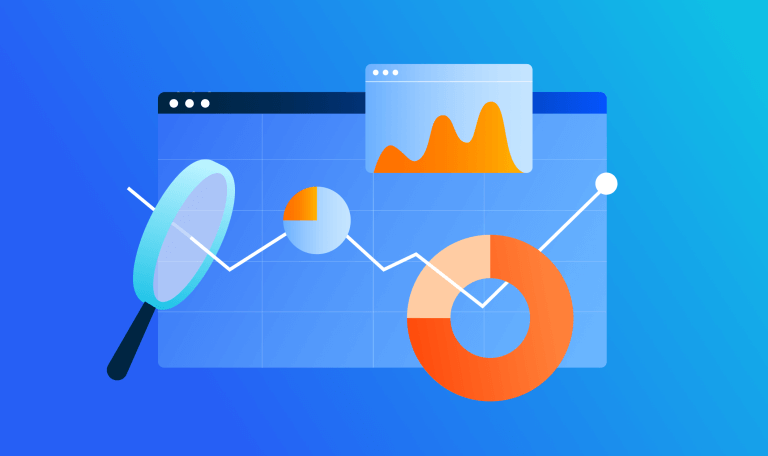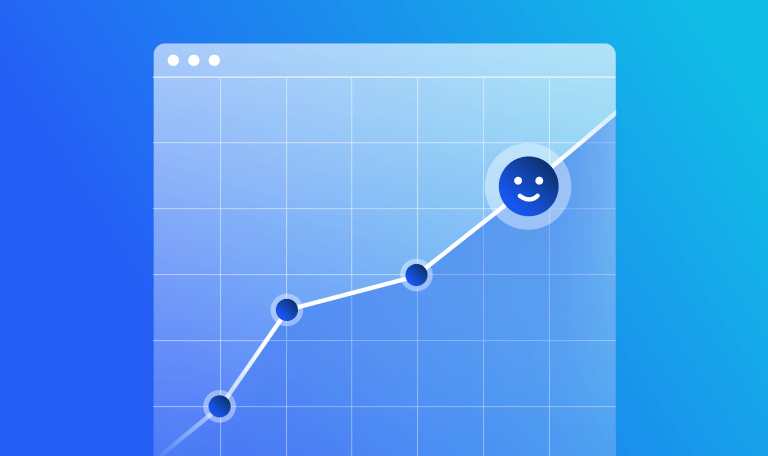Mastering B2B Market Research: A Step-by-Step Guide

Market research is pivotal to any business’s success in the digital world. You need it to understand your customers’ needs and preferences, identify threats from competitors, track market trends, reduce churn risk…the list goes on and on.
However, your business type will dictate how you conduct market research and which metrics are most important to meeting your goals. For example, if you’re a B2C company, you’ll aim to understand individual consumer behavior and preferences. But if you sell primarily to other businesses, you must conduct B2B market research. The nuances between the two are subtle but important.
Keep reading as we walk you through the basics of B2B market research, including different methods and tools, so you can make informed decisions and stay competitive in an ever-evolving digital environment.
What is B2B market research?
The core of market research is all about collecting and analyzing data about a target market or defined segment. It’s an intricate process that gives you the insights you need to make the best decisions for your business, including product launches, market expansions, marketing campaigns, budget allocation, and more.
But who you are researching depends on your target audience. Business-to-business (B2B) market research focuses on understanding businesses’ needs, preferences, and behaviors rather than individual customers. You define your consumer as the business itself.
Unlike B2C market research, which focuses on the interactions between a business and individual people, with B2B market analysis, you’re studying how different businesses work together, what they can offer each other, and how to create a mutually beneficial relationship. While most of the time, B2B market research methods will focus on how you can sell to another business; you may also use it to find new opportunities for partnerships and collaborations.
The importance of market research to B2B companies
Like traditional online market research, B2B analysis is crucial as it helps you understand where you stand vis-a-vis competitors. With it, you can identify your market position and better understand where new opportunities lie. It will also help you find new customers and better engage with existing ones so you see a greater return on your investments.
B2B user research will help you make well-informed, data-driven decisions, especially if you follow a systematic approach using a market research tool like Similarweb.
Here are some of the main benefits of B2B market research:
Define your target audience – In this case, your target audience is other businesses rather than individual customers. Like traditional audience analysis, you must define their pain points, preferences, and online behavior. Understanding their challenges is crucial for developing products and offering services that meet their needs.
Build loyal customer relationships – Customer satisfaction is important for any business, but for B2B businesses, it’s essential for retaining customers. You’ll be able to build strong relationships by continuously meeting their needs.
Pinpoint promising market opportunities – Which geos are you looking to go after primarily? Are there new areas that could increase your market share, or should you focus on a more niche audience with less competition? Determining where your book of business is largest will affect how you run campaigns and where you invest the most effort. B2B user research will also help you understand if there are any regulatory or cultural differences in the regions you’re hoping to expand to.
Conduct competitive analysis – Any good strategy starts with competitive analysis. Find out what your competitors are offering their customers and how your offering compares.
Optimize your pricing strategy – B2B research can help you understand how much your customers expect to pay for your service, given market conditions and competitor pricing. Make sure that the price you offer is comparable to the service you are providing.
Mitigate any risk – When launching a new product, entering a new market, or attempting to reach a new audience, you need reliable data and insights-driven research to mitigate risks.
Uncover industry trends – Detect, monitor, and analyze any trends in your industry that could affect what customers are looking for. This includes emerging players, new technologies, the state of the economy, and more.
And then innovate – Once you have a better idea of the trends shaping consumer behavior, you can improve your existing products or create new services to keep up with ever-changing demand.
Different types of B2B market research methods
There are a variety of methods you can use to conduct your research. We suggest using a mix so you’re not limited to only one strategy, as each will help you answer different questions.
Let’s take a look at the four main types of B2B market research:
Primary market research
Primary market research is the first-hand collection of data. This data can be obtained through a variety of B2B market research tools, but your main focus is looking directly at your customers’:
Web Metrics – Use website traffic analytics to understand how you perform online compared to your competitors. You should check if specific market segments outperform others and try to find out if it’s because of a specific offering or UX. Don’t forget to measure engagement metrics, such as bounce rate, pages per visit, and session duration, to understand how your audience interacts with your website.

Web metrics analysis using the Similarweb platform.
Observation – Install software that records visits and creates heatmaps of your website so you can understand your user’s journey through your site. This type of research can work in parallel with website analytics, qualifying any findings that you make about user experience on certain pages.
Customer surveys – Surveys are an extremely effective form of B2B user research to help you learn more about your current customers. Distribute questionnaires and polls to your database via email, site chatbot, or social media. Ask questions that can give you qualitative data (what type of business are they?) and quantitative data (how many employees do they currently have working for them?). You should include both open-ended and multiple choice questions so you can get some personal feedback from your customer (what’s a new product or feature you’d like to see us offer?), as well as answers to important pre-determined questions (how many people in your team currently use our product?).
Focus groups – If you want to get even more personal, then focus groups are a great way to get a small group together to discuss your business. You can choose either customers or prospects depending on the questions you’d like to ask and the conclusions you want to make.
Secondary market research
Secondary market research uses data that has already been published. Unlike primary market research, which is for your eyes only, secondary market research is available to anyone. While it’s not exclusively yours, this data type is preferred for anyone hoping to keep costs low or have quick access to the information they need.
Government reports and census data – Government organizations frequently publish reports that are great high-level overviews, including the state of the economy and the conditions of financial markets. Most of these reports are published annually or quarterly, so check often for the most updated version to get the freshest data.
Competitor websites – Imitation is the highest form of flattery! A great source of secondary market research is to look at what your competitors are doing. Check out how they highlight competing features, cover blog topics, and target SEO keywords. You could also conduct a SWOT analysis to pinpoint your strengths, weaknesses, opportunities, and threats.

Competitor marketing channel mix using the Similarweb platform
Media outlets – Check the news and other media publications to see if any major events are affecting your industry. It’s a great way to keep up with current events impacting your customers.
Qualitative market research
Qualitative market research is one of the best ways to understand customers’ feelings about a brand, product, or service. It measures what comes to their mind whenever they hear your company’s name. It takes more time to analyze the results than other market research types, as it’s more about emotions- and opinions-based.
By understanding the sentiments of your customers, you will be able to shape and develop products, services, and digital strategies that are most important to them.
Here are a few methods for B2B qualitative research:
- Focus groups
- Case study or whitepaper
- Online forums
- Surveys
- Biometrics
- Ethnography
Quantitative market research
Last on our list is quantitative market research, which focuses solely on collecting, analyzing, and comparing data. This is where you’re crunching the numbers. This data can forecast trends, size a new market, validate a market entry plan, or establish customer patterns.
Since the data you collect will be reliable, you can replicate and automate processes with a similar methodology. Often, there are fewer variables in data collection compared to qualitative research. There are three core methods of data collection that you’ll use to conduct quantitative research:
- Interviews
- Surveys
- Polls
ABM campaigns
ABM stands for Account-Based Marketing. Although ABM campaigns can be considered more of a marketing tactic than traditional B2B research, it’s important to understand the high-value accounts that can drive the most impact for your business.
For example, let’s say you’re Hubspot, a software company that sells a content management platform for ecommerce businesses. With your platform, these companies can list inventory, track sales, follow up on deliveries, and even collect payments in one place. After conducting market research, you discover an up-and-coming ecommerce player that fits your target audience. This company has the chance to bring with it a substantial pipeline.
Rather than casting a wide net and launching a new marketing campaign in the hopes that someone at this company will click on your LinkedIn Ad or open an email, you run an ABM campaign.
Because ABM campaigns are more personalized, your marketing efforts will complement that company’s pain points, products, and even staff. For ABM campaigns to be effective, you want to make sure that you focus on strategic high-value accounts, use tailored messaging to build stronger relationships, and align your efforts with sales to nurture the relationship further.
How to conduct B2B market research using Similarweb
Now that you know the ins and outs, it’s time to learn how to do B2B market research.
You may not know where to begin or which metrics are the most important, but having a market research tool like Similarweb is invaluable.
The tools you’ll find inside help you make sense of all that data so you can solve the most complex business challenges with data-driven decisions. Although the uses are endless, here are four ways you can use Similarweb to conduct B2B market research:
1. Company research
Use the company research tool to understand how your customers are performing online while also pinpointing new potential prospects based on their digital footprint.
With Similarweb, you can uncover the digital strategies and tactics of any company by device, country, and marketing channel, compare full-funnel traffic, engagement, and conversion metrics.
This is an important step of B2B market research for two reasons. First, you can show your customers how your product or service directly impacts their growth online by monitoring changes in metrics from before and after they started working with you. Suppose you’re trying to find new prospects. In that case, you can use Similarweb Digital Research Intelligence to analyze the industry you’re targeting and discover the top-performing companies that would be lucrative business partners. Once you’ve identified these companies, you can also use Similarweb Sales Intelligence to validate and find the best leads.
2. Competitive benchmarking
While most of your B2B market research will look at your customers, you always want to watch the competition. That’s where business benchmarking comes in. Our Benchmarking tool compares and measures your business’s digital performance against competitors or the industry average. It’s a great way to determine industry best practices and identify opportunities for improvement.
You can use this data to pinpoint underperforming marketing or sales strategies, optimize your content, and even find areas for new market growth.
Here are some KPI ideas we recommend when benchmarking your business as part of your B2B research strategy:
- Increase web traffic by __%
- Launch x new products into a new target market within the next ½ year.
- Increase monthly active users on a mobile app by 5%
- Engage users – improve session duration or growth rate by __%
- Increase app store ranking by 5% on Android and/or iOS
- Reach top 2 results on ranking on (define keywords)
- Improve share of voice in ___ topic from __% to __%.
- Increase brand awareness – improve branded traffic share by __%

Benchmarking Traffic and Engagement metrics with Similarweb
3. Audience analysis
Knowing who you sell to is pivotal to your B2B market research strategy. That’s where audience analysis comes in. Understanding your target demographics allows you to build customized product offerings and personal marketing strategies.
Here’s an example of using Similarweb to conduct audience analysis. Unpack demographics for any site or industry you choose, including data on gender, age, location, interests, browsing habits, and more.

Using Similarweb to understand your audience’s demographics
4. Marketing channel performance
With insight into how different marketing channels are performing, you can find out the most effective ways to reach potential customers and ensure that you’re allocating the right budget for paid advertising.
Similarweb Marketing Intelligence makes this type of research easy. Look below at a snapshot from within our Marketing Channels tab, providing an overview of performance across direct, organic search, social media, email, paid search, and display ads. Check which convert the most and where the highest channel traffic comes from. For the ecommerce industry in the US, direct and organic search drive the most traffic to the top websites, whereas referrals and paid search are the most effective paid marketing channels.
Take the first step in acing B2B market research
B2B market analysis is key to staying ahead in the digital landscape. It will guide you through customer needs, competitor landscapes, and market trends.
Empower your business with comprehensive market insights and stay ahead of the curve with Similarweb Digital Research Intelligence. Whether you’re just starting or consider yourself a seasoned market research pro, we have all the necessary tools.
Take the next step in refining your B2B market strategy – sign up for Similarweb today.
FAQs
What is B2B market research?
B2B market research is the process of studying a business’s needs, preferences, and behaviors as a whole rather than individual customers. You define your target customer as the business itself.
Why is B2B market research important?
B2B market research is important as it helps you understand where you stand vis-a-vis competitors. With it you can identify threats, get a better picture of new opportunities, and find out how to connect more with your customers. It will also help you find new prospects to increase ROI.
What are the four main types of B2B market research?
The four main types of B2B market research include primary, secondary, qualitative, and quantitative.
How can you use Similarweb to support your B2B market research?
You can use Similarweb Digital Research Intelligence in various ways to support your B2B market research, including company research, competitive benchmarking, audience analysis, marketing channel performance, and more.
Track your digital metrics and grow market share
Contact us to set up a call with a market research specialist















